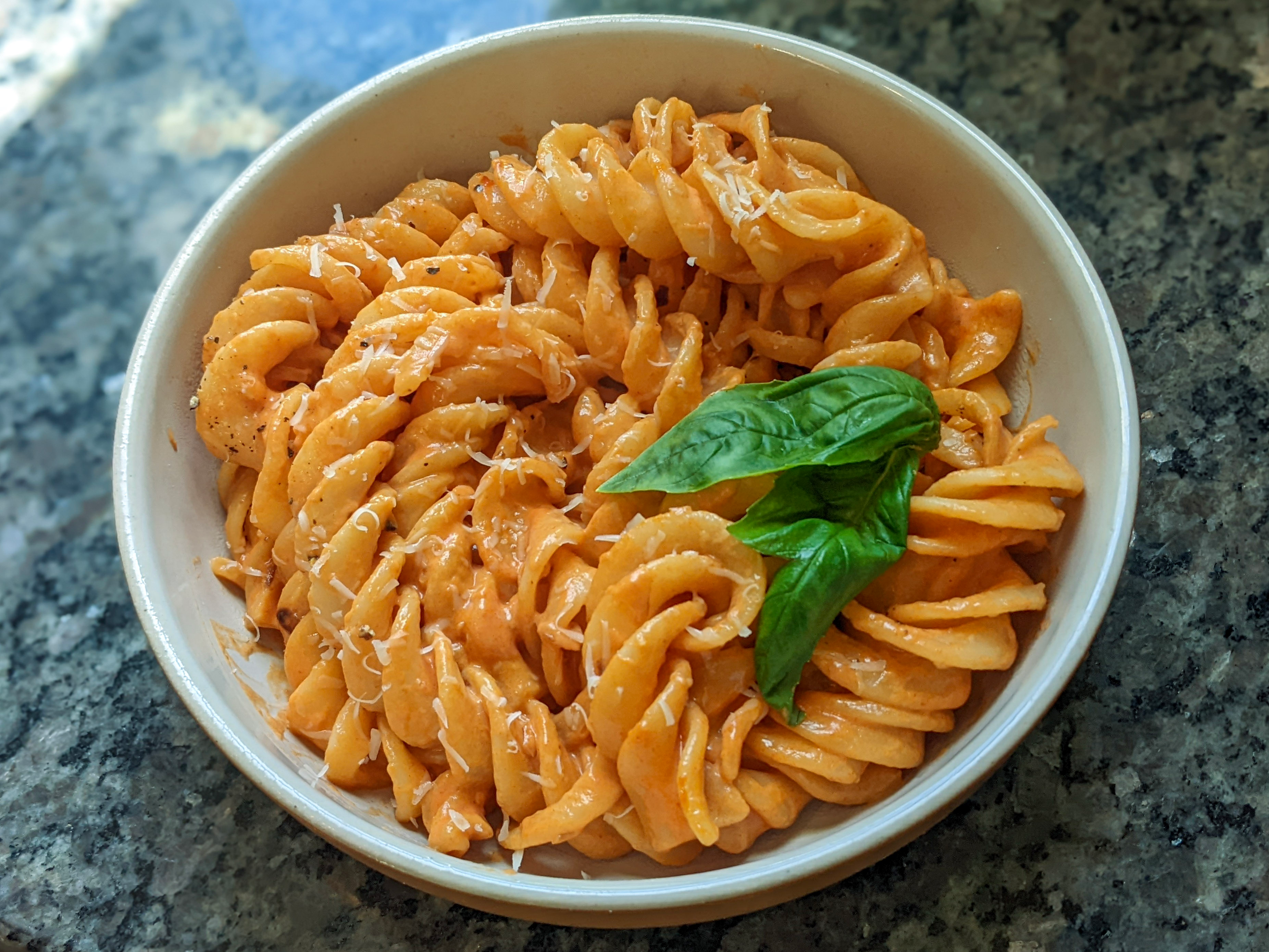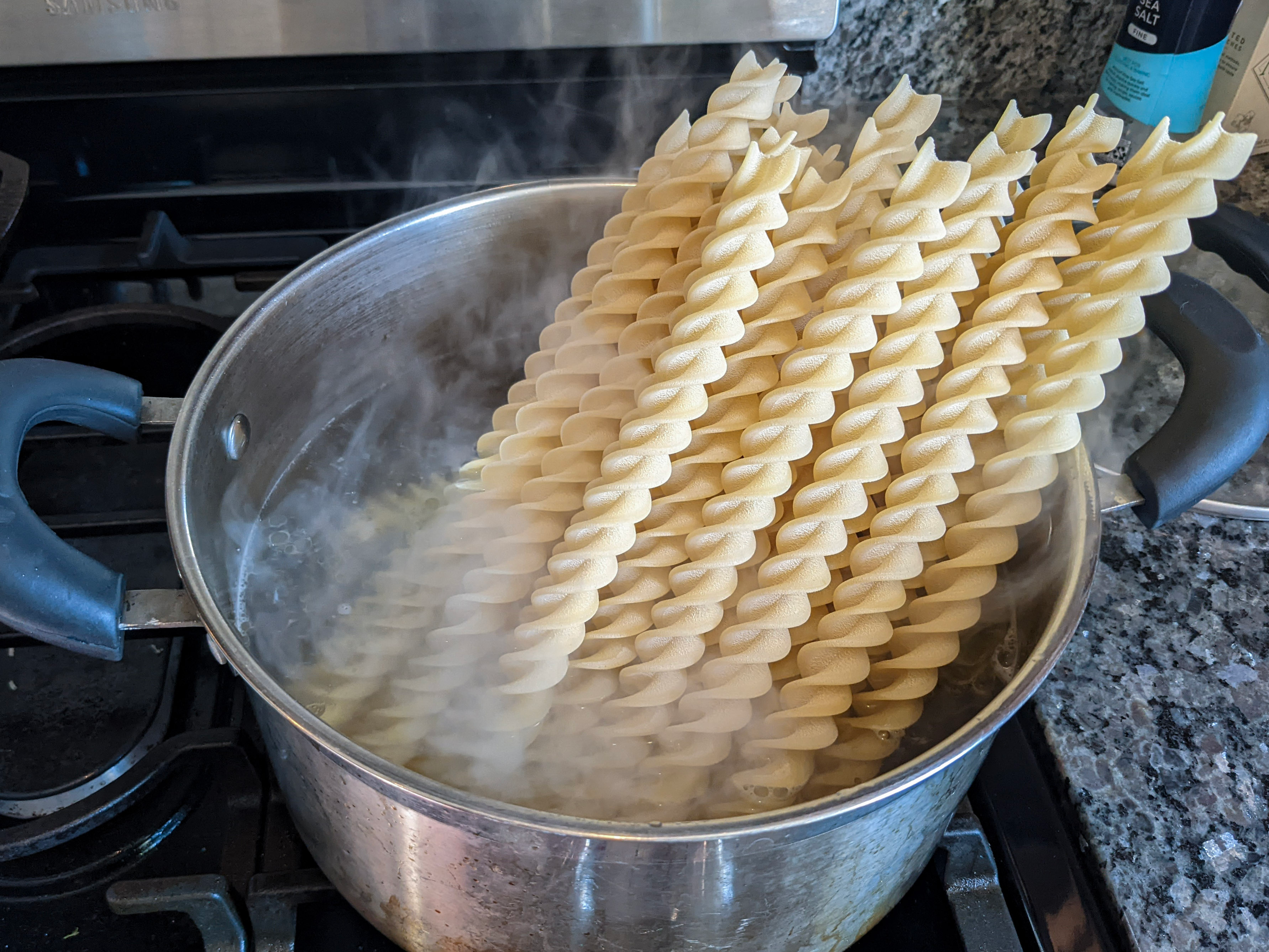Once You Eat Giant Fusilli, You'll Never Go Back
Indulging in the spectacle of colonne Pompeii, “the internet’s favorite pasta.”
Fusilli as we know it in the United States is a cute little noodle. The curly pasta is often served in pasta salad or with pesto and is a seen as a lesser member of the pasta pantheon. Sure, its curls are good for trapping sauce and meat, but it just lacks the verve of long, elegant noodles like fettuccine or bucatini.
That's how I felt for a long time, until I saw TikTok user @foodsofjane prepare a fusilli alla vodka that changed my perception forever. Using a pasta branded as colonne Pompeii ("columns of Pompeii"), she makes what looked like a bowl full of telephone cords coated in pinkish tomato sauce. I watched as she twirled the noodles—gigantic, 12-inch-long fusilli—on her fork and giggled as she tried to chow them down.
@foodsofjane My favorite noodle shape is prepastarous!! Collone Pompeii Pasta paired with easy homemade vodka sauce. (Pasta sauce recipe on FoodsofJane.com.)
In the 18 months since @foodsofjane posted that video, colonne Pompeii has become a nascent trend, with the good folks at La Fabbrica della Pasta Gragnano, who produce the branded noodle, clearly landing some influencer placements with their tantalizingly long take on fusilli.
I was fascinated. I thought pasta miracles like this were reserved for the pages of Strega Nona. How have I been eating this boring noodle my whole life not knowing that, for $9.99 plus shipping, I could have downright enormous fusilli in my bowl? Are there other noodles that have long-cut cousins? How about extension cords of ziti? Cavatappi as long as a child's forearm?

Let’s talk about fusilli
Online pasta shop Piccolo's Gastronomia lists 65 or so different varieties of fusilli, 17 of which are long (fusilli lunghi in Italian). Four are made by La Fabbrica della Pasta Gragnano, which like many of the varieties is named for a town in Southern Italy.
Fusilli is traditionally made by wrapping the dough around a wire called a fuso, thus the noodle's name—though some argue that fusilli actually comes from fusile, meaning "rifle." When the noodle was handmade, it was traditionally long like colonne Pompeii (though not as fat), but when the first industrial fusilli maker was invented in 1924, it became more common for the noodle to be short-cut. Much of the fusilli made or imported to the United States is industrial made, so this became the shape familiar to Americans.
"Gragnano is a town where bronze-extruded, long dried pasta starts to be mass produced, and so it's really the cradle of dried pasta production," says Rome-based, New Jersey–born food writer Katie Parla, author of Foods of the Italian South. "In the Bay of Naples, there probably are 20-ish pasta makers that are recognized as part of the IGP, and each company makes, like, 100 or more shapes. The shapes that they make are sometimes gimmicky."
Fusilli is often confused for rotini, a tightly coiled pasta shape with slightly deeper folds. American manufacturers often use the names interchangeably, but there is a technical difference: rotini is extruded in its springy shape, not coiled around a wire. Sure, fine.
The variants I buy are fusilli Sorrento (a skinner version of colonne Pompeii), fusilli Capri (a looser, double-braided variant), fusilli col buco (a hollowed-out version), and of course colonne Pompeii, which Piccolo's calls "the interent's favorite pasta."
Parla confirms that colonne Pompeii is not commonly eaten in Italy, and she says the La Fabbrica della Pasta Gragnano is often found in airports, where it's marketed to tourists. She supposes that the noodle's ridiculous format makes it expensive to dry and produce, and that (along with the novelty) is what contributes to the lofty price tag.
"In the late 19th century through the mid-20th century, with the major industrial design advances, there was tons of entrepreneurial spirit to make a product that people were going to want to keep eating," Parla says. "A long fusillo takes a long-ass time to cook. A shorter fusillo is easier to cook but also a lot easier to eat. The difficult-to-eat shapes like bucatini remain super regional. I would imagine that a fusilli, if you serve it to a whole family of different ages and different skill levels, is going to be real hard to eat."
Why giant fusilli is simply better
According to Bon Appetit, short noodles go best with dishes that include "larger ingredients tossed in with the noodles and sauce, whether they be beans, roasted vegetables, or olives," whereas long noodles are apt for simple, classic sauces like carbonara, bolognese, and Alfredo. But I decide to make a vodka sauce for my colonne Pompeii, because I want to see how the freakish noodle holds up to something simple and classic.
The downside of giant fusilli becomes apparent the moment you go to boil water. You'll need something big enough to submerge the entire noodle—a lobster pot or a dutch oven. I didn't quite have that, so I had to let the bottoms of the noodles soften and then force the tops halves under the surface. It also takes about twice as long to come to al dente. In all, it took about 20 minutes to get the full noodle, through to the core, to the point it wasn't crunchy. But when they were done and tossed in the sauce, it all came together.
The sauce found its way into every crevice, sticking to the noodle like a creamy tar. Parla is right, it does take some strategic forking. But once I got the hang of piercing a noodle, coiling it, and bringing it to my mouth, it brought a richness of flavor I've never experienced with spaghetti or linguine. Unlike short-cut fusilli, you don't have to worry about noodles slipping off the fork or furiously stabbing around to get enough on the fork. Every bite was saturated with flavor, and my two-year-old daughter marveled as she ate each strand end-to-end like a Twizzler.
It's obvious why colonne Pompeii appeals to TikTok audiences. It's shocking enough to stop you mid-scroll, and there is a visual intrigue to watching a stranger in your feed wrangle a footlong fusillo. It might not be as practical or economical as its shorter sibling, but once you've wrangled colonne Pompeii, anything else seems boring.

